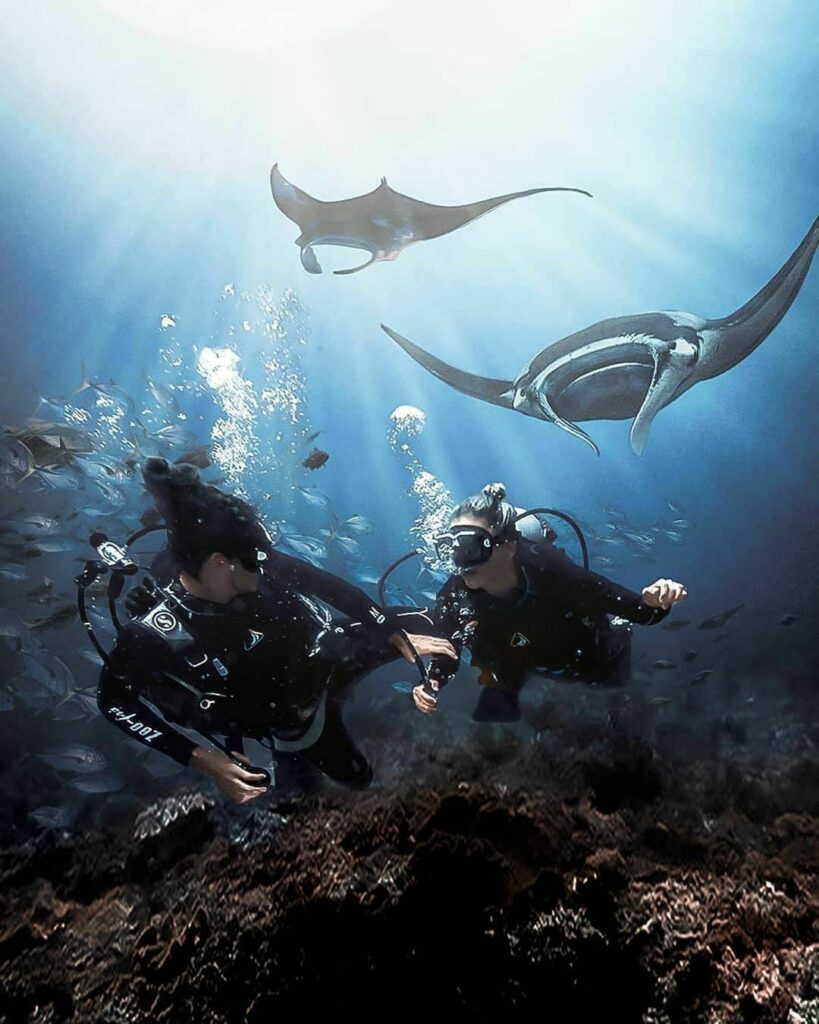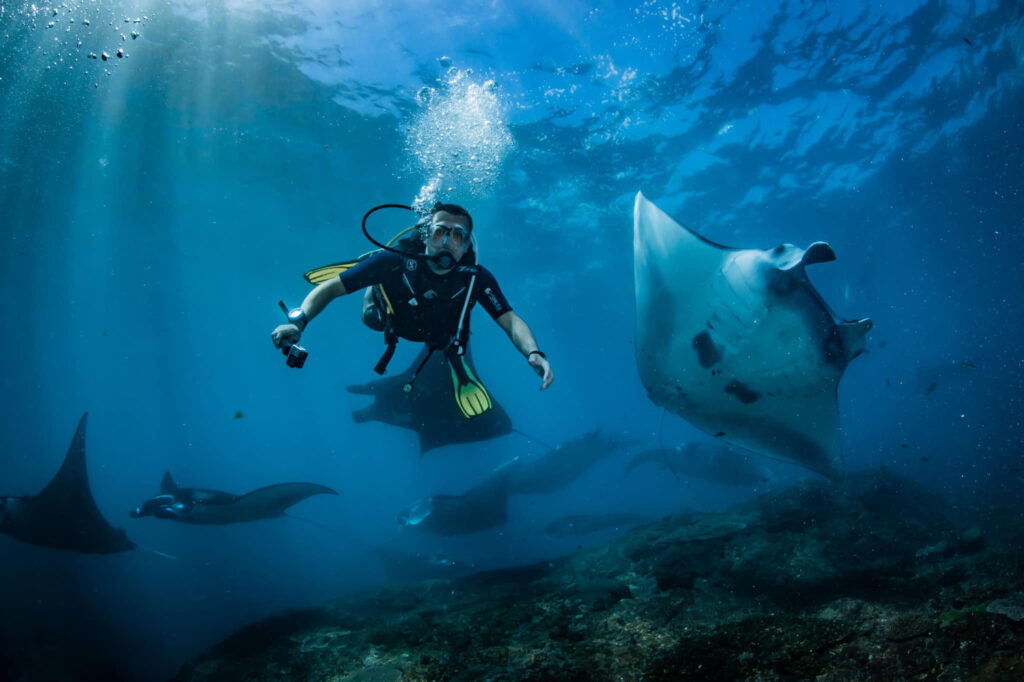Manta rays are one of the most majestic creatures in the sea. And what better place to see them than in Indonesia? Diving in Indonesia is the perfect way to get up close with these gentle giants, with its warm waters and rich marine life!

The majestic manta ray: Why these creatures are so special?
Manta rays are interesting because they are large, graceful animals that can glide through the water with ease. They are also gentle creatures that pose no threat to humans.
Manta rays are one of the most beautiful and graceful creatures in the ocean. But there’s more to these animals than meets the eye. These gentle giants are actually keystone species, meaning they play a vital role in the health of the marine ecosystem.
Manta rays are filter feeders, meaning they strain plankton, small fish, and other tiny organisms from the water as they swim. This helps to keep the water clean and healthy. Manta rays are also important predators. By eating large amounts of smaller fish, they help to keep the population in check.
But manta rays are in trouble. They are often caught as bycatch in fisheries and are threatened by habitat loss and degradation. They are also targeted by the illegal wildlife trade.
Diving with manta rays is one of the most magical experiences you can have in the water. These gentle giants are truly amazing animals. But we have to do our part to protect them. We can start by supporting sustainable fisheries and businesses that are working to conserve manta rays and their habitat.

Why diving in Indonesia is an experience not to be missed?
Indonesia is home to some of the world’s most biodiverse marine life, and what better way to experience it than by diving in Indonesia with manta rays?
Manta rays are gentle giants of the sea, and can often be found in Indonesia’s waters. Diving with them is an unforgettable experience, and one that is sure to leave you with a renewed appreciation for the underwater world.
Not only is diving with manta rays an amazing experience, but it is also a great way to help conserve these magnificent creatures. Manta rays are currently listed as “vulnerable” by the International Union for the Conservation of Nature (IUCN), and so it is important to do what we can to protect them.
Diving with manta rays is a great way to help with this, as it helps to raise awareness of their plight and also provides much needed income for local communities who are often the first to suffer when wildlife is in trouble.
So, if you’re looking for an amazing diving experience that will also help to make a difference, then diving with manta rays in Indonesia is the perfect choice!
The best scuba diving spots in Indonesia: Where can I scuba dive with Manta Rays?
Here are some of the best diving spots in Indonesia where you can see manta rays up close.
1. Nusa Penida, Bali
Nusa Penida is an island off the southeast coast of Bali. It is well known for its clear water and rich marine life. There are many dive spots around the island, but one of the best places to see manta rays is at Manta Point. This is a cleaning station where manta rays come to have their food removed by smaller fishes. You can often see up to 20 manta rays at Manta Point, making it a great place to see these amazing creatures up close while diving in Indonesia.
2. Nusa Lembongan, Bali
One of the best places to see manta rays in while diving in Bali is at Nusa Lembongan. This is a small island located off the southeast coast of Bali. The waters around Nusa Lembongan are rich in nutrients, which attract manta rays and other marine life.
3. Komodo National Park
Komodo National Park is located in the Lesser Sunda Islands of Indonesia. It is best known for its population of Komodo dragons, but it is also home to a rich variety of marine life. The park is a great place to go diving, with many dive spots that offer the chance to see manta rays. One of the best places to see manta rays in Komodo National Park is at Batu Bolong. This is a small island located between Komodo and Rinca islands. The waters around Batu Bolong are rich in nutrients, which attract manta rays and other marine life.
4. Raja Ampat
Raja Ampat is an archipelago located off the northwest coast of Papua, Indonesia. It is home to a rich variety of marine life, including manta rays. Raja Ampat is a great place to go diving in Indonesia, with many dive spots that offer the chance to see manta rays up close. One of the best places to see manta rays in Raja Ampat is at Manta Sandy. This is a small sandy island located between two coral reefs. The waters around Manta Sandy are rich in nutrients, which attract manta rays and other marine life
5. Lombok
Lombok is an Indonesian island located in the Indian Ocean. It is well known for its beaches, temples and coral reefs. Lombok is also a great place to go diving, with many dive spots that offer the chance to see manta rays up close. One of the best places to see manta rays in Lombok is at Gili Trawangan. This is a small island located off the northwest coast of Lombok. The waters around Gili Trawangan are rich in nutrients, which attract manta rays and other marine life.

Tips for divers: How to make the most of your diving experience with Manta Rays?
These gentle giants are a joy to watch, and their graceful movements make for an unforgettable experience.
Here are a few tips to help you make the most of your time with the manta rays while diving in Indonesia:
- Make sure you have your camera ready. These creatures are truly photogenic, so you’ll want to capture as many memories as possible.
- Don’t touch the manta rays. Although they are harmless, they are wild animals and should not be touched.
- Be respectful of their space. Mantas are curious creatures, but they need their space. Don’t crowd them or chase them, and give them a wide berth when you’re swimming.
- Be patient. Mantas are notoriously shy, so it may take a while for them to warm up to you.
- Stay close to your group. It’s always best to dive with a group, and this is especially true when swimming with manta rays. They are attracted to groups of people, so staying close to your buddies will help you see more of them.
By following these simple tips, you’re sure to have a safe and memorable experience diving with manta rays!
Why everyone should dive with manta rays at least once in their lifetime?
Manta rays are one of the most gentle and beautiful creatures in the sea. They are harmless to humans and are often curious about us.
Diving with manta rays is an experience you will never forget. These creatures are so graceful and majestic, it’s hard not to be awestruck in their presence.
Not only are they a joy to watch, but manta rays are also good for the environment. They help keep the ocean clean by eating plankton and other small organisms.
If you’ve never gone diving with manta rays before, what are you waiting for? It’s an experience you won’t regret. The best time to visit Nusa Lembongan is from June to September. This is when the manta rays come to the island to feed on the plankton that blooms in the waters.
Talk to us today for diving trips to Nusa Penida, one of the best diving spot in Indonesia, to catch a glimpse of these majestic Manta Rays!


Wow, I’m loving the way this blog post has highlighted the beauty of manta rays! It’s amazing to see how they glide through the water with such ease and majesty. As a scuba diver myself, I can attest that diving with manta rays is an experience like no other.
Hi Rizalina, thanks for sharing your love for manta rays! We’re thrilled to hear that you’ve had the experience of diving with them. At our resort, we’re passionate about not only providing an unforgettable experience for our guests but also making a positive impact on the local community and marine life. Our dedicated training facilities for local staff and surrounding areas are just one way we’re working towards this mission. We’d love to have you join us in our efforts to protect these magnificent creatures and their habitats. If you’re interested in learning more about our initiatives or even joining us on a diving trip, please feel free to reach out to us at [email protected] or +62 857 3891 8262. We look forward to hearing from you! And who knows, maybe we’ll see you swimming alongside the manta rays again soon.
I completely agree! Manta rays are indeed a sight to behold. I’ve had the privilege of diving with them in Nusa Penida, and it’s an experience that left me breathless. The way they swim alongside you, their gentle giant nature… it’s truly mesmerizing.
Wow, Khairol Syafiq! We’re thrilled to hear that you’ve had an amazing experience diving with manta rays in Nusa Penida. Our resort is committed to protecting these incredible creatures and their habitats. That’s why we’ve dedicated training facilities for our local staff and surrounding communities. By supporting sustainable tourism and conservation efforts, we can make a real impact on the environment. We’d love to invite you to join us on this mission to change the world, one resort at a time. Contact us at [email protected] or +62 857 3891 8262 for more information.
I’ve always been fascinated by manta rays! This blog post has really opened my eyes to the importance of conservation efforts. It’s crucial that we protect these magnificent creatures and their habitats. I hope more people will learn about the plight of manta rays and take action.
Dear Nur Aina Nazirah, we’re thrilled to hear that our blog post has inspired you to take action in protecting manta rays and their habitats. At Pebble & Fins, we believe that education is key to making a positive impact on the environment. By sharing knowledge and experiences with others, we can work together to create a better future for these incredible creatures. If you’re interested in learning more about our conservation efforts or would like to get involved, please don’t hesitate to contact us at [email protected] or +62 857 3891 8262. We’d be delighted to hear from you and explore ways we can work together to make a difference. Thank you for your passion and commitment to protecting our planet’s incredible marine life.
This is an enlightening and well-rounded post, offering both helpful diving tips and vital considerations towards manta ray conservation. It certainly makes me want to experience the wonders of diving with manta rays in Indonesia.